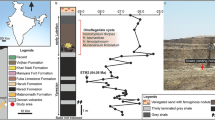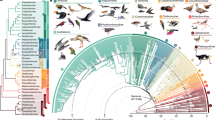Abstract
The evidence that extinctions since the mid-Permian show periodicity of ˜26 million years rests primarily on the stratigraphic ranges of marine families. We have checked the echinoderm and fish families which together make up about 20% of the data. Only 25% of these fish and echinoderm extinctions are real (disappearance of a monophyletic group). The remaining 75% is noise, chiefly 'extinctions' of non-monophyletic groups, mistaken dating, and 'families' containing one species only. The signal-to-noise ratio is very similar in echinoderms (27:73) and fishes (23:77). Periodicity in our sample is a feature of the noise component, not of the signal.
This is a preview of subscription content, access via your institution
Access options
Subscribe to this journal
Receive 51 print issues and online access
$199.00 per year
only $3.90 per issue
Buy this article
- Purchase on Springer Link
- Instant access to full article PDF
Prices may be subject to local taxes which are calculated during checkout
Similar content being viewed by others
References
1. Raup, D. M. & Sepkoski, J. J. Proc. natn. Acad. Sci. U.S.A. 81, 801-805 (1984). 2. Sepkoski, J. J. & Raup, D. M. in Dynamics of Extinction (ed. Elliott, D. K.) 3-36 (Wiley, New York, 1986). 3. Raup, D. M. & Sepkoski, J. J. Science 231, 833-836 (1986). 4. Sepkoski, J. J. in Patterns and Processes in the History of Life (eds Raup, D. M. & Jablonski, D.) 277-295 (Springer, Berlin, 1986). 5. Hoffman, A. & Ghiold, J. Geol Mag. 122, 1-4 (1985). 6. Hoffman, A. Nature 315, 659-662 (1985). 7. Sepkoski, J. J. & Raup, D. M. Nature 321, 533 (1986). 8. Gilinsky, N. L. Nature 321, 533-534 (1986). 9. Kitchell, J. A. & Estabrook, G. Nature 321, 534-535 (1986). 10. Hoffman, A. Nature 321, 535-536 (1986). 11. Jablonski, D. Paleobiohgy 10, 139-145 (1984). 12. Hallam, A. Nature 308, 686-687 (1984). 13. Kerr, R. A. Science 227, 1451-1453 (1985). 14. Kitchell, J. A. & Pena, D. Science 226, 689-672 (1984). 15. Hoffman, A. N. Jb. Geol Paldont. Abh. 172, 219-244 (1986). 16. Connor, E. F. in Patterns and Processes in the History of Life (eds Raup, D. M. & Jablonski, D.) 119-147 (Springer, Berlin, 1986). 17. Flessa, K. W. et al in Patterns and Processes in the History of Life (eds Raup, D. M. & Jablonski, D.) 235-257 (Springer, Berlin, 1986). 18. Raup, D. M. Palaeontology 30, 1-13 (1987). 19. Benton, M. J. Nature 314, 496-497 (1985). 20. Raup, D. M. Science 231, 1528-1533 (1986). 21. Rampino, M. R. & Stothers, R. B. Nature 308, 709-712 (1984). 22. Schwartz, R. D. & James, P. B. Nature 308, 712-713 (1984). 23. Whitmire, D. P. & Jackson, A. A. Nature 308, 713-715 (1984). 24. Davis, M., Hut, P. & Muller, R. A. Nature 308, 715-717 (1984). 25. Alvarez, W. & Muller, R. A. Nature 308, 718-720 (1984). 26. Whitmire, D. P. & Matese, J. J. Nature 313, 36-38 (1985). 27. Sepkoski, J. J. Contr. Biol Geol. Milwaukee publ. Mus. 51, 1-125 (1982). 28. Harland, W. G. et al. A Geological Time Scale (Cambridge University Press, 1982). 29. Moore, R. C., Teichert, C. & Robison, R. A. (eds) Treatise on Invertebrate Paleontology (Geological Society of America and University of Kansas, Lawrence, Kansas, 1953-1986). 30. Harland, W. B. et al. (eds) The Fossil Record (Geological Society of London, 1967). 31. Romer, A. S. Vertebrate Paleontology, 3rd edn (University of Chicago Press, 1966). 32. Simpson, G. G. The Major Features of Evolution (Columbia University Press, New York, 1953); Principles of Animal Taxonomy (Columbia University Press, New York, 1961). 33. Van Valen, L. M. Evol. Theory 1, 1-30 (1973); Nature 307, 50-52 (1984). 34. Stanley, S. M. Macroevolution: Pattern and Process (Freeman, San Francisco, 1979). 35. Hennig, W. Syst. Zool. 24, 244-256 (1975). 36. Kier, P. M. J. Paleont. 48 (Suppl. to No. 3: Mem. 5), 1-95 (1974). 37. Fischer, A. G. & Arthur, M. A. Spec. Publs Soc. econ. Paleont. Miner. Tulsa 25,19-50 (1977). 38. Thomson, K. S. Nature 261, 578-580 (1976). 39. Thomson, K. S. Devs Palaeont. Stratigr. 5, 377-404 (1977).
Author information
Authors and Affiliations
Rights and permissions
About this article
Cite this article
Patterson, C., Smith, A. Is the periodicity of extinctions a taxonomic artefact?. Nature 330, 248–251 (1987). https://doi.org/10.1038/330248a0
Received:
Accepted:
Issue Date:
DOI: https://doi.org/10.1038/330248a0
This article is cited by
-
A flourishing of fish forms
Nature (2010)
-
The role of fossils in phylogeny reconstruction: Why is it so difficult to integrate paleobiological and neontological evolutionary biology?
Biology & Philosophy (2004)
-
Determinants of extinction in the fossil record
Nature (2002)
-
Middle Yangtze sea-basin over Paleozoic-Mesozoic transition
Science in China Series D: Earth Sciences (2002)
-
Absolute measures of the completeness of the fossil record
Nature (1999)
Comments
By submitting a comment you agree to abide by our Terms and Community Guidelines. If you find something abusive or that does not comply with our terms or guidelines please flag it as inappropriate.



